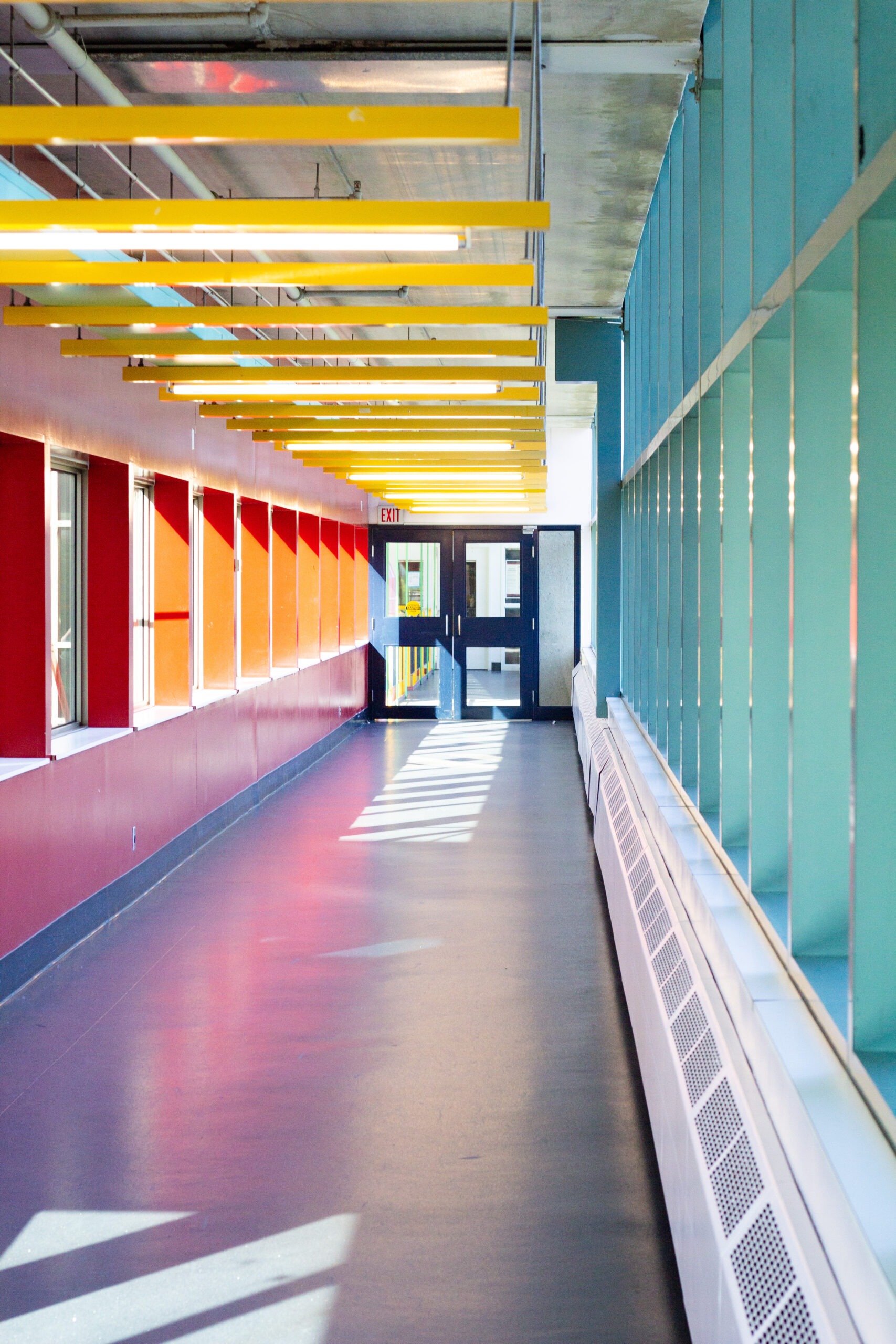An introduction to tunnels and bridges on campus
| September 19, 2024

A brightly lit hallway with colorful accents resembles a vibrant campus corridor. Yellow ceiling beams contrast with red and teal walls, while large windows on one side allow sunlight to stream in, casting shadows on the dark floor. At the end, double doors create a gateway to new discoveries.
A brightly lit hallway with colorful accents resembles a vibrant campus corridor. Yellow ceiling beams contrast with red and teal walls, while large windows on one side allow sunlight to stream in, casting shadows on the dark floor. At the end, double doors create a gateway to new discoveries.
New to campus this year and looking for the best shortcuts? Dreading the trek to class once winter hits? You’re not alone. While there are some buildings that require you to brave the outdoors, there are quite a few tunnels and bridges available across campus. If you’re anything like me, though, the prospect of navigating an underground pathway for the first time can sound pretty intimidating, too. That’s why this introductory guide aims to outline the major routes around campus. From the bridges of DC to the Arts Quad tunnels, you’ll be navigating UW’s shortcuts in no time.
Arts Quad tunnels
The largest network of tunnels winds through the Arts Quad on campus. In total, these tunnels connect six buildings (or eight, if the environment buildings are counted as separate entities): South Campus Hall (SCH), the Tatham Centre (TC), the Arts Lecture Hall (AL), Modern Languages (ML), Hagey Hall (HH), and the environment buildings (EV1, EV2, EV3). Though you can access the tunnels from any of these buildings, the system officially “starts” in SCH. You’ll know you’ve found it if you’re standing in a bright orange hallway underground. From there, you can head to TC, then to AL. From AL, you can access ML and EV1 (EV2 and 3 are connected by doorways to EV1). Finally, there is a tunnel from EV1 to HH. That may all sound very complicated, but there are lots of signs and arrows throughout the tunnels to help you find your way. If you’re an arts student like me, these tunnels can be a big help when rushing from class to class.
Cross-campus bridges: from SLC/PAC to DC
If you’re looking to get all the way across campus without stepping foot outside, these bridges are for you. I can’t tell you how many times I’ve made use of these in the winter months to get from the university colleges all the way to the ION track or the bus stations. This trip consists of two parts, and two bridges: first, there’s the bridge from the Student Life Centre/Physical Activities Complex (SLC/PAC) to the Mathematics and Computer building (MC). This bridge is glass-panelled, and can be clearly seen from outside. The next bridge runs from MC to Davis Centre (DC). Once you’ve reached the DC Library you can make your way outside, where you’ll be standing at Ring Road, directly across from the ION tracks and bus stations. Of course, DC itself is one of the largest buildings on campus, and it connects to a number of other buildings through additional bridges. From DC, you can take bridges to Mathematics 3 (M3), Chemistry 2 (C2), and Engineering 3 (E3).
Engineering buildings
If you’re an engineering student, there are many bridges and pathways you can take. Firstly, E3 leads directly into Engineering 2 (E2) by doorway. E3 also boasts the “E5 Bridge”: this bridge runs across Ring Road and the ION tracks, leading to Engineering 5 (E5). Like the SLC bridge, it’s glass-panelled and is clearly visible from the outside — and those who cross it can enjoy a great view of the city. E5 is then attached to E7, and from E7 you can take another bridge to E6. These bridges can be useful even if you’re not attending engineering classes: anyone heading to the University Plaza can access it easily by exiting out of E6. (Remember, you can use bridges to arrive here all the way from SLC if you want to!)
Miscellaneous shortcuts
Feeling overwhelmed with directions yet? We’re almost done, but some final notes about bridges and tunnels will be listed below:
There is a tunnel connecting MC and C2.
E2 is connected by bridges to the Douglas Wright Engineering Building (DWE) and the Physics building (PHY), and to Carl A. Pollock Hall (CPH) by a series of doorways.
Earth Sciences and Chemistry (ESC) and the Centre for Environmental and Information Technology (EIT) are connected by both a bridge and a tunnel.
The J.R. Coutts Engineering Lecture Hall (RCH) is connected by tunnels to E2 and to DWE.
More buildings connected to each other by doorway: all of the environment buildings; EIT and PHY; and B1, B2, and the Science Teaching Complex (STC).
Finally, there is a pedestrian bridge over University Avenue, which leads from CPH to Parking Lot A. However, this bridge will be closed until September 2026 due to the construction of a new residence building.
Now that’s a lot of shortcuts! Even so, there are more that haven’t been listed here — if you’re feeling particularly ambitious, explore and find some for yourself. There is lots of information about (and even maps of) these shortcuts online, so don’t be afraid to look for more help when navigating your way across campus. Hopefully some of these suggestions will help you, especially during cold and rainy days!
Share this story
More
Campus News, Local News
City of Waterloo cracks down on unlicensed rentals, encourages tenants to know their rights
Veronica Reiner
| December 18, 2025
News
UW student in Gaza faces ongoing challenges amid war and visa delays
Carla Stocco
| December 17, 2025
Campus News
Students lead candid conversations at gender-based violence forum
Emma Danesh
| December 11, 2025
Arts & Life
EDI-R opens free podcasting space for students, staff, and faculty
Veronica Reiner
| December 9, 2025



